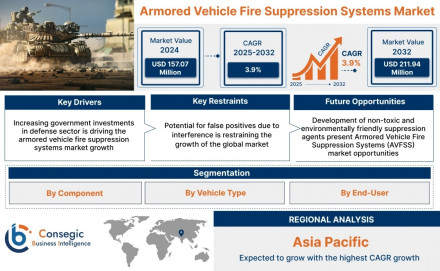Armored Vehicle Fire Suppression Systems Market: Growth and Future Outlook (2025-2032)

Armored Vehicle Fire Suppression Systems Market Introduction:
Armored vehicle fire suppression systems are integrated safety mechanisms designed to detect and extinguish fires within military, law enforcement, and commercial armored vehicles. These systems play a critical role in improving crew survivability and minimizing vehicle damage during combat or hazardous operations. The demand for such systems has surged due to the growing complexity of combat scenarios, the need for troop safety, and an increasing emphasis on advanced defense technology across the globe. These systems typically use agents like dry chemical powders, gases (such as FM-200 and CO2), or foam to rapidly suppress fires in engine compartments, crew cabins, and ammunition storage areas.
Armored Vehicle Fire Suppression Systems Market Overview:
The armored vehicle fire suppression systems market is experiencing steady growth, driven by escalating geopolitical tensions, increasing military budgets, and the modernization of armed forces globally. These systems are vital components in armored personnel carriers (APCs), infantry fighting vehicles (IFVs), mine-resistant ambush-protected (MRAP) vehicles, and main battle tanks (MBTs). The market includes products from both global defense contractors and specialized fire protection firms. Technological innovations such as automatic fire detection, dual-agent suppression technologies, and modular system designs are influencing market dynamics. Additionally, stringent military safety regulations are contributing to widespread adoption.
Armored Vehicle Fire Suppression Systems Market Size:
Armored Vehicle Fire Suppression Systems Market Size is estimated to reach over USD 211.94 Million by 2032 from a value of USD 157.07 Million in 2024 and is projected to grow by USD 162.00 Million in 2025, growing at a CAGR of 3.9% from 2025 to 2032.
Armored Vehicle Fire Suppression Systems Market Includes Drivers, Restraints & Opportunities
Drivers:
- Rising Military Spending: Nations across the world, including the U.S., China, India, and NATO countries, are investing heavily in modernizing their defense fleets, including fire protection systems for armored vehicles.
- Increasing Threat of Asymmetric Warfare: The rise in unconventional warfare, including IEDs and ambushes, has elevated the importance of internal fire safety in armored vehicles.
- Focus on Crew Safety: Governments and defense organizations are prioritizing the safety of military personnel, pushing for systems that ensure survivability during fire incidents.
- Adoption of Advanced Technologies: Integration of AI-based detection, IoT-enabled alert systems, and automatic suppression mechanisms is fueling demand for next-gen fire suppression solutions.
Restraints:
- High Installation and Maintenance Costs: Advanced fire suppression systems involve significant capital investment, which may deter procurement, especially for countries with limited defense budgets.
- Technological Complexity: The integration of complex systems requires highly trained personnel and precise calibration, making deployment and maintenance a challenge.
- Supply Chain Issues: The defense industry often faces delays due to geopolitical tensions, trade restrictions, or component shortages, impacting timely delivery of fire suppression systems.
Opportunities:
- Upgrading Aging Military Fleets: Many countries are in the process of retrofitting older armored vehicles with modern safety systems, offering a large aftermarket opportunity.
- Emergence of Unmanned Ground Vehicles (UGVs): The rising deployment of robotic military vehicles creates demand for compact, autonomous fire suppression systems.
- Private Security and Law Enforcement Vehicles: There is increasing adoption of armored vehicles in private security and police forces, expanding the market beyond traditional military use.
- Integration with Vehicle Health Monitoring Systems: Fire suppression can be integrated with broader vehicle diagnostic systems, enabling predictive maintenance and enhanced safety protocols.
Armored Vehicle Fire Suppression Systems Market Competitive Landscape Analysis (Key Players)
- Kidde-Deugra Brandschutzsysteme GmbH (Germany)
- N2 Towers Inc. (Canada)
- Fire Protection Technologies Pty Ltd. (Australia)
- Lifeline Fire and Safety Systems (United Kingdom)
- Spectrex (U.S.)
- Halma plc (United Kingdom)
- BEL|Bharat Electronics Limited (India)
- Marioff Corporation (Finland)
- Elbit Systems (Israel)
- Firetrace International (U.S.)
Armored Vehicle Fire Suppression Systems Market Industry Segmentation:
By Component
- Detectors
- Suppressants
- Control Panels
- Others
By Vehicle Type
- Combat Vehicles
- Troop Transport Vehicles
- Others
By End-User
- Military
- Law Enforcement
By Region
- Asia-Pacific
- Europe
- North America
- Latin America
- Middle East & Africa
Regional Analysis of the Armored Vehicle Fire Suppression Systems Market:
North America- U.S.: The largest contributor in the region due to high military spending, extensive armored vehicle fleets, and adoption of cutting-edge fire suppression technologies.
- Canada: Investing in armored vehicle upgrades under the National Defence Procurement Strategy, driving moderate demand for AVFSS.
- Mexico: Emerging interest in vehicle safety systems for military and federal forces amid ongoing internal security efforts.
- Europe
- U.K.: A key market due to participation in NATO and modernization of its Challenger tank and Boxer vehicle programs.
- Germany: Strong defense manufacturing sector and initiatives like the Puma IFV upgrades support AVFSS demand.
- France: Emphasizing soldier and vehicle protection under the Scorpion program, which includes AVFSS.
- Spain: Increasing defense allocation for vehicle protection measures.
- Italy: Invests in mechanized forces modernization, boosting AVFSS installations.
- Asia-Pacific
- China: Expanding military capability with large-scale production of armored vehicles—strong demand for advanced fire suppression systems.
- Japan: Limited but focused demand due to constitutional constraints, mainly in Self-Defense Forces' vehicle protection.
- Middle East & Africa
- Includes nations such as Saudi Arabia, UAE, South Africa, and Egypt.
Latin America
- Primarily driven by Brazil, Argentina, and Chile.
Armored Vehicle Fire Suppression Systems Market Recent Developments:
- 2024: Kidde Technologies launched a new compact suppression system for light armored vehicles, enhancing its product portfolio.
- 2024: Firetrace International partnered with the U.S. Army for testing autonomous fire suppression systems for unmanned combat vehicles.
- 2023: European defense consortiums announced joint R&D investments in smart suppression systems as part of the PESCO defense initiatives.
- 2023: Oshkosh Defense integrated next-gen fire suppression into its JLTV (Joint Light Tactical Vehicle) models.
- 2022: Increased focus on non-toxic suppression agents led to innovations in environmentally friendly suppression technologies.
Contact us:
Consegic Business intelligence Pvt Ltd.
Contact no: (US) (505) 715-4344
Email: sales@consegicbusinessintelligence.com

